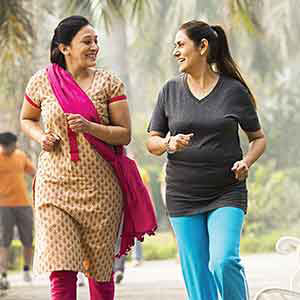Women – God’s Wonderful Creation and Nice Gift to Mankind
We have a vision where women and girls live in dignity, are healthy, have choices and equal opportunities. But, if fortune turns against you, even a jelly can break your teeth. So, it’s always better to make street smart choices in all areas.
Women the so called “multitasking domestic engineers” of the society should focus on the four-letter mantra.

H- healthy life style
E- efficiency to work
A-achieve in all grounds
L- live and let live
If we focus into women’s good health at 360-degree approach, healthy diet, optimum nutrition, life style and awareness become the essential components and the factors which influences all these is sedentary life style, genetic influences, nature vs nurture, low micro nutrient intake, early hysterectomy, etc.
Transitional state from one stage to next is quite challenging to all women.
In nutritionist perspective, balanced diet is one of the best ways to handle.
Eating a well-balanced diet is essential for good health. The foundation of a nutritious diet is to eat a wide variety of foods in moderation.
The Indian food pyramid has 6 food groups.
- Cereals and grains
- Vegetable and fruits
- Milk and milk products
- Pulses and nuts
- Meats, poultry, fish and eggs
- Fats and sweets
Cereals and Grains:
These include rice, chapattis, bread, pasta, idiyappam, oats, kanji, etc. They form the largest component of our diet. They provide carbohydrates for energy and some vitamins and minerals. They can also be a source of fibre if we use whole grains and unrefined flours such as atta.
We should consume 5 – 12 servings of cereals and grains in a day.
- 1 serving = 1 large slice of bread
- 1 chapatti
- ½ cup rice, upma or pasta
- 1 cup of kanji
- 1 idly/1 dosa/1 uthappam
NOTE: 1 cup = 200ml
Vegetables and Fruits:
This category includes all cooked vegetables, salads, greens, fruits and fruit juices. This should be the next largest item on our diets. Fruits and vegetables provide many vitamins and minerals such as vitamin C, carotene, folic acid, iron, magnesium and potassium. They are excellent source of fibre and also add colour to our diet. They are rich in anti-oxidant which may protect us from diseases and provide energy too.
We should eat 5 – 10 servings of fruits and vegetables per day.
- 1 serving = 1 medium sized fruit like apple/banana
- ½ cup fruit juice
- ½ cup cooked vegetables
- 1 cup salad
Milk and Milk Products:
These are milk, paneer, cheese, curds, ice creams, butter milk, etc. This group provides us with protein and energy as well as calcium and phosphorus. We should consume 2 – 4 servings of milk and milk products.
- 1 serving = 1 cup (200ml) milk
- ¾ cup curds
- 50g (2 slices) cheese
Pulses and Nuts:
These includes all dhal, rajma, chick peas, dried peas, grams (moong, soya bean, urud, black), etc. This group is a rich source of protein, energy and soluble fibre.
- 1 serving = ½ cup solid or thick pulses
- 1 cup sambhar
- ¼ cup nuts
Meat and Meat Products:
These include mutton, beef, pork, chicken, eggs, fish, shellfish, etc. This group provide high quality protein, iron and some vitamins.
- 1 serving = 1 egg
- 50 – 100g cooked meat or fish/poultry
We should eat 2 – 3 servings of pulses or nuts or meat groups.
Fat and Sweets:
Fats include cooking oil, ghee, butter and sweets in the form of sugar, honey, chocolates, jams, etc. You may also find a combination of fats, sweets and grains in food such as cakes, Indian sweets and pies. It is best to keep the amount of fats and sweets that you consume at a minimum – e.g., 2 tsp oil to season a side dish, 2tbsp for a curry for 4 persons.
How Many Servings of Each Group Should You Consume?
The number of serving required varies from person to person, depending on age, sex, weight and activity level. Based on these factors, the requirements can be on the higher or lower end of the number of servings specified.
Under doctor’s prescription and dietician’s planning, customised menus can be designed.
GENERAL GUIDELINES FOR A HEALTHY DIET:
- Choose a variety of foods from different food groups.
- Use whole grains and unrefined flour products over foods made with white flour (maida) and polished rice.
- Select lower fat foods like skimmed milk instead of homogenized full cream milk andpoultry instead of beef or mutton.
- Choose yellow, dark green and orange vegetables more often.
- Limit your intake of salt, fats, sugar and caffeine.
- Avoid colas and fizzy drinks as they contain very high amount of sugars.
- Keep consumption of deep-fried foods like bajjis and pakodas to a minimum amount.
- Choose high fibre foods like pulses, dhal, vegetables and fruits.
- Reading food labels is must when you buy products from shops.
Other Foods:
Salt: Use moderate amount of salt.(10 -15 grams/day)
Caffeine: Consumption of caffeine-containing drinks and foods such as coffee, tea, colas and chocolate should be moderate.
Fluids:
The average adult needs about 2litres or 8 glasses of water or other fluids a day. This excludes caffeine containing drinks and fizzy drinks as they tend to increase water gain. The amount of water you need will vary depending on the temperature and the activity level.
Dear Body,
I apologize for not treating you properly. I have not been eating right and have been neglecting you. I promise to do what is needed to get you back into the best possible shape. We can definitely achieve this!
Sincerely,
Me.
You are not 40, it is 39.5 plus shipping and handling.
E – eat right, e – exercise regularly, e – eliminate stress,
e – educate yourself about your body.

Mrs. A.P.Yamini, MSc RD
Lead Clinical Dietitian
Kauvery Hospital, Chennai

